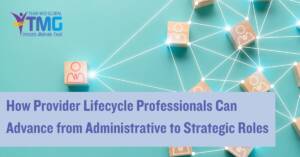
Provider Lifecycle Professionals (PLPs) play a critical role in ensuring that providers are ready, compliant, and able to deliver care — but that’s just the beginning of our impact.
Whether you’re focused on credentialing, enrollment, licensing, or quality, the work you do impacts access to care, regulatory compliance, revenue flow, and patient safety. That means you’re already in a position of influence. The next step? Shifting from an administrative role to a strategic role.
Here’s how to make that shift — without waiting for a promotion or title change.
Know Your Value — and Communicate It Clearly
Strategic PLPs understand the why behind their work and can articulate it to others. Don’t just say you submit credentialing applications — explain how timely credentialing supports faster provider onboarding, which in turn protects revenue and reduces gaps in care. Reframe your everyday tasks as outcomes. Instead of “tracking expirables,” think: “ensuring continuous compliance.” Language matters. The more clearly you connect your work to organizational priorities, the more strategic you’ll be perceived.
Get Curious About the Bigger Picture
Ask questions that go beyond your current responsibilities:
- What are our organization’s goals around provider access?
- What’s our average turnaround time for enrollment — and how does it compare to others?
- What are the financial impacts of delays or denials?
By seeking context, you start to understand how your strategic role fits into larger workflows — and where there are opportunities to improve them.
Look for Patterns and Propose Solutions
Strategic thinkers don’t just complete tasks — they analyze what’s working and what’s not. If you notice recurring issues (like missing documents from the same department or common delays from specific payers), bring it up. Better yet, bring a potential solution. For example:
“We’ve had five enrollment delays this quarter tied to incomplete applications. Could we standardize our intake checklist to avoid these gaps?”
Even small process improvements show initiative — and build your strategic credibility.
Build Cross-Functional Relationships
To think strategically, you need insight into how other departments operate. Talk to colleagues in compliance, HR, revenue cycle, and medical staff leadership. Find out what their biggest pain points are and how your work intersects with theirs. These relationships not only increase your visibility — they also help you spot collaboration opportunities you might have missed from your silo.
Document — and Share — Your Impact
Track metrics that matter. Did your team reduce application errors by 30%? Did your new workflow cut credentialing time in half? Numbers tell a compelling story. Share your wins in team meetings, performance reviews, and email updates. Strategic professionals don’t just do the work — they advocate for its value.
The Bottom Line
You don’t need a title to have a strategic role. You need awareness, initiative, and follow-through. When you understand how your daily work connects to organizational outcomes—and you take steps to improve processes, build relationships, and communicate your impact—you’re helping to shape the future of your organization.
That’s the power of a strategic PLP.

